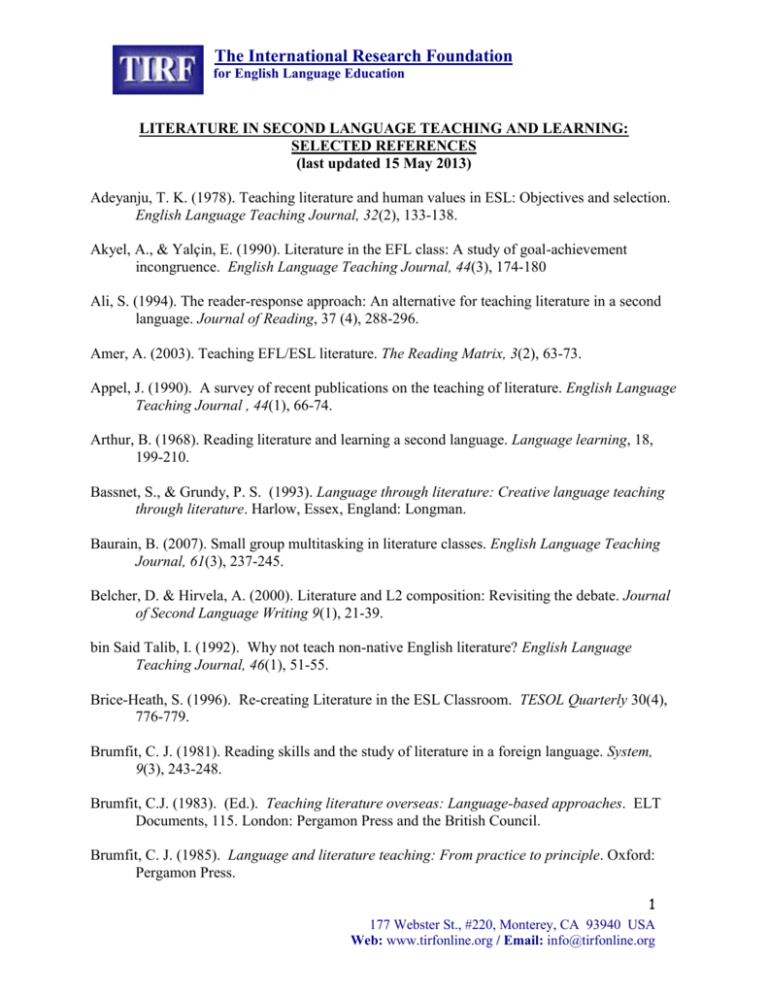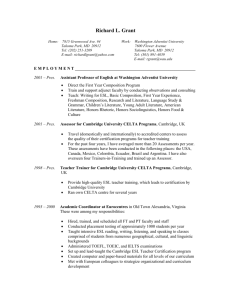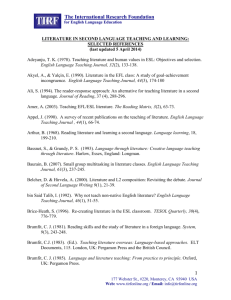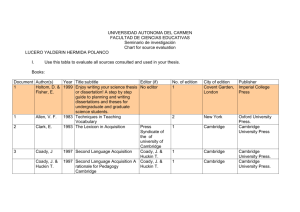Additional References - TESOL International Research Foundation
advertisement

The International Research Foundation for English Language Education LITERATURE IN SECOND LANGUAGE TEACHING AND LEARNING: SELECTED REFERENCES (last updated 15 May 2013) Adeyanju, T. K. (1978). Teaching literature and human values in ESL: Objectives and selection. English Language Teaching Journal, 32(2), 133-138. Akyel, A., & Yalçin, E. (1990). Literature in the EFL class: A study of goal-achievement incongruence. English Language Teaching Journal, 44(3), 174-180 Ali, S. (1994). The reader-response approach: An alternative for teaching literature in a second language. Journal of Reading, 37 (4), 288-296. Amer, A. (2003). Teaching EFL/ESL literature. The Reading Matrix, 3(2), 63-73. Appel, J. (1990). A survey of recent publications on the teaching of literature. English Language Teaching Journal , 44(1), 66-74. Arthur, B. (1968). Reading literature and learning a second language. Language learning, 18, 199-210. Bassnet, S., & Grundy, P. S. (1993). Language through literature: Creative language teaching through literature. Harlow, Essex, England: Longman. Baurain, B. (2007). Small group multitasking in literature classes. English Language Teaching Journal, 61(3), 237-245. Belcher, D. & Hirvela, A. (2000). Literature and L2 composition: Revisiting the debate. Journal of Second Language Writing 9(1), 21-39. bin Said Talib, I. (1992). Why not teach non-native English literature? English Language Teaching Journal, 46(1), 51-55. Brice-Heath, S. (1996). Re-creating Literature in the ESL Classroom. TESOL Quarterly 30(4), 776-779. Brumfit, C. J. (1981). Reading skills and the study of literature in a foreign language. System, 9(3), 243-248. Brumfit, C.J. (1983). (Ed.). Teaching literature overseas: Language-based approaches. ELT Documents, 115. London: Pergamon Press and the British Council. Brumfit, C. J. (1985). Language and literature teaching: From practice to principle. Oxford: Pergamon Press. 1 177 Webster St., #220, Monterey, CA 93940 USA Web: www.tirfonline.org / Email: info@tirfonline.org The International Research Foundation for English Language Education Brumfit, C. J., & Carter, R. A. (1986). Literature and language teaching. Oxford: Oxford University Press. Buss, K., & Karnowski, L. (2000). Reading and writing literary genres. Newark, DE: International Reading Association. Carroli, P. (2008). Literature in second language education: Enhancing the role of texts in learning. London: Continuum. Carter, R., & Long, M. N. (1987). The Web of Words. Cambridge: Cambridge University Press. Carter, R., & Long, M. N. (1990). Testing literature in EFL classes: Tradition and innovation. English language Teaching Journal, 44 (3), 215-221. Carter, R., & McRae, J. (Eds.). (1996). Language, literature, and the learner: Creative classroom practice. London: Longman. Chandella, N. (2011). The lighting of a fire: The value of dialogic in the teaching and learning of literature for EF/SL learners at the university- level in the UAE. Exeter, UK: University of Exeter, Exeter Research and Institutional Content (ERIC). Chandella, N. (2013). Better to be than not to be: Towards a creative interpretation of Shakespeare. In A. Roscoe & R. Al-Mahrooqi (Eds.), Literature teaching in EFL/ESL: New perspectives (pp. 282-301). Muscat, Oman: Sultan Qaboos University Press. Collie, J. & Porter Ladousse, G. (1992). Paths into poetry. Oxford: Oxford University Press. Collie, J., & Slater, S. (1987). Literature in the language classroom. Cambridge: Cambridge University Press. Cook, G. (1997). Making the subtle difference: Literature and non-literature in the classroom. In R. Carter & J. McRae (Eds.), Language, literature and the learner: Creative classroom practice (pp. 151-165). London and New York: Longman Addison Wesley Ltd. Davis, J. (1989). The act of reading in the foreign language: pedagogical implications of Iser’s reader-response theory. The Modern Language Journal, 73 (4) 420- 428. Duff, A., & Maley, A. (1989). Literature. Oxford: Oxford University Press. Elliot, R. (1990). Encouraging reader-response to literature in ESL situations. English Language Teaching Journal , 44(3), 191-198. 2 177 Webster St., #220, Monterey, CA 93940 USA Web: www.tirfonline.org / Email: info@tirfonline.org The International Research Foundation for English Language Education Fabb, N., Attridge, D., Durant, A., & MacCabe , C. (Eds.). (1987). The linguistics of writing: Arguments between language and literature (pp. 48-66). Manchester: Manchester UP. Falvey, P., & Kennedy, P. (1997). Learning language through literature. Hong Kong: Hong Kong University Press. Gower, R. (1986). Can stylistic analysis help the EFL learner to read literature? English Language Teaching Journal, 40(2), 125-13. Ghosn, I. K. (2002). Four good reasons to use literature in primary school ELT. English Language Teaching Journal, 56(2), 172-179. Heath, S. B. (1996). Re-creating literature in the ESL classroom. TESOL Quarterly, 30, 776-779. Hill, J. (1987). Using literature in language teaching. Cambridge: Cambridge University Press. Hirvela, A. (1990). ESP and literature: A reassessment. English for Specific Purposes, 9(3), 237252. Hirvela, A. (1996). Reader-response theory and ELT. ELT Journal, 50,(2) 127-34. Hirvela, A., & Boyle, J. (1988). Literature courses and student attitudes. English Language Teaching Journal, 42(3), 179-184. Khatib, M., Rezaei, S., & Derakhshan, A. (2011). Literature in the EFL/ESL classroom. English Language Teaching, 14, 1, 201-208. Langer, J. A. (2010). Envisioning literature: Literary understanding and literature instruction (2nd ed.). New York: Teachers College Press. Lazar, G. (1993). Literature and language teaching: A guide for teachers and trainers. Cambridge: Cambridge University Press. Lazar, G. (1994). Using literature at lower levels. English Language Teaching Journal, 48(2), 115-124. Lazar, G. (1996). Exploring literary texts with the language learner. TESOL Quarterly, 30, 773776. Liyong, T. I. (2013). Language, literature and nation building: A personal history. In H. McIlwraith (Ed.), Multilingual education in Africa: Lessons from the Juba Language-inEducation Conference (pp. 225-230). London: British Council. 3 177 Webster St., #220, Monterey, CA 93940 USA Web: www.tirfonline.org / Email: info@tirfonline.org The International Research Foundation for English Language Education Maley, A. (1989). Down from the pedestal: Literature as resource. In R. Carter, R. Walker & C. Brumfit (Eds.)., Literature and the learner: methodological approaches. (pp. 1-9). London: Modern English Publications and the British Council. Maley, A. (1989). A comeback for literature? Practical English Teacher, 10, 59. Maley, A. (1993). Short and Sweet I. Harmondsworth: Penguin. Maley, A. (1995). Short and Sweet II. Harmondsworth: Penguin. Maley, A. (2001). Literature in the language classroom. In R. Carter & D. Nunan (Eds.), The Cambridge guide to teaching English to speakers of other languages (pp. 180-185). Cambridge: Cambridge University Press. Maley, A. (2006). English through literature. Beijing: Central Radio and TV University Press. Maley, A., & Duff, A. (1989). The inward ear. Cambridge: Cambridge University Press. Maley, A., & Duff, A. (2005). Drama Techniques (3rd Edition). Cambridge: Cambridge University Press. Maley, A., & Moulding, S. (1985). Poem into poem. Cambridge: Cambridge University Press. Maley, A., & Mukundan, J. (2011). (Eds.). Writing poems: A resource book for teachers of English. Kuala Lumpur: Pearson Malaysia. Maley, A., & Mukundan, J. (2011). (Eds.). Writing stories: A resource book for teachers of English. Kuala Lumpur: Pearson Malaysia. Manvell, R. (1973). Literature and drama become film. English Language Teaching Journal, 27(3), 292-301. Mackay, R. (1992). Lexicide and goblin-spotting in the language/literature classroom. English Language Teaching Journal, 46(2), 199-208. McConochie, J. (1982). All this fiddle: Enhancing language awareness through poetry. In M. Hines & W. Rutherford (Eds.), On TESOL ‘80 (pp. 231-240). Washington, D.C.: TESOL. McRae, J. (1991). Literature with a small ‘l’. Basingstoke: Macmillan. McRae, J., & Vethamani, M. E. (1999). Now read on. London: Routledge. McKay, S. (1982). Literature in the ESL classroom. TESOL Quarterly, 16(4), 529-536. 4 177 Webster St., #220, Monterey, CA 93940 USA Web: www.tirfonline.org / Email: info@tirfonline.org The International Research Foundation for English Language Education McKay, S. (2001) Literature as Content for ESL/EFL. In M. Celce-Murcia (Ed,), Teaching English as a second or foreign language (pp. 319-332). Boston: Heinle & Heinle. Morgan, J., & Rinvolucri, M. (1983). Once upon a time. Cambridge: Cambridge University Press. Nasr, N. (2001). The use of poetry in TEFL: Literature in the new Lebanese curriculum. Revista de Filología y su Didáctica, 24, 345-363. Oster, J. (1989). Seeing with different eyes: Another view of literature in the ESL class. TESOL Quarterly, 23, 85-103. Paran, A. (2000). Recent books on the teaching of literature. English Language Teaching Journal, 54(1), 75-88. Parkinson, B., & Thomas, H. R. (2001). Teaching literature in a second language. Edinburgh: University of Edinburgh Press. Popp, M. S. (2005). Teaching language and literature in elementary classrooms: A resource book for professional development (2nd ed.). Mahwah, NJ: Lawrence Erlbaum. Povey, J. (1967). Literature in TESL programs: the language and the culture. TESOL Quarterly, 1(2), 40-46. Preston, W. (1982). Poetry ideas in teaching literature and writing to foreign students. TESOL Quarterly 16, 4, 489-502. Quirk, R., & Widdowson, H. G. (Eds.). (1985). English in the world: Teaching and learning the language and literatures (pp.1 1-30). Cambridge: Cambridge University Press. Picken, J. (2005). Helping foreign language learners to make sense of literature with metaphor awareness-raising. Language Awareness, 14(2-3), 142-152. Robson, A. E. (1989). The use of literature in ESL and culture-learning courses in US colleges. TESOL Newsletter, 23, 25-27. Rönnqvist , L., & Sell, R. D. (1994). Teenage books for teenagers: Reflections on literature in language education. English Language Teaching Journal, 48(2), 125-13. Ross, N. J. (1991). Literature and film. English Language Teaching Journal, 45, 2, 147-155. Rossner, R. (1991). The whole story. London: Longman. 5 177 Webster St., #220, Monterey, CA 93940 USA Web: www.tirfonline.org / Email: info@tirfonline.org The International Research Foundation for English Language Education Rozema, R., & Webb, A. (2008). Literature and the Web: Reading and responding with new technologies. Portsmouth, NH: Heinemann. Shelton-Strong, S. J. (2011). Literature Circles in ELT. English Language Teaching Journal, 66(2), 214-223. Spack, R. (1985). Literature, reading, writing, and ESL: Bridging the gaps. TESOL Quarterly, 19, 703-725. Stern, S. L. (1991) An integrated approach to literature in ESL/EFL. In M. Celce-Murcia (Ed.) Teaching English as a second or foreign language (2nd ed.) (pp. 328-349).Boston: Heinle & Heinle. Tayebipour, F. (2009). In Defence of Teaching literature to EFL students in the era of globalization. In L.J. Zhang, R. Rubdy, & Alsagoff (Eds.), Englishes and Literatures-inEnglish in a Globalised World: Proceedings of the 13th International Conference on English in Southeast Asia (pp. 213-219). Singapore: National Institute of Education, Nanyang Technological University. Timucin, M. (2001). Gaining insight into alternative teaching approaches employed in an EFL literature class. Revista de Filología y su Didáctica, 24, 269-293. Taylor, Eric, K. (2000). Using folk tales. Cambridge: Cambridge University Press. Tomlinson, B. (1994). Openings. Harmondsworth: Penguin. Tomlinson, B. (2001). Connecting the mind: A multi-dimensional approach to teaching language through literature. The English Teacher, 4(2)104-114. Topping, D. M. (1968). Linguistics or literature: An approach to language. TESOL Quarterly, 2(2), 95-100. Van, T.T.M. (2009). The relevance of literary analysis to teaching literature in the EFL classroom. English Teaching Forum, 3, 2-9. Vandrick, S. (1996). Issues in using multicultural literature in college ESL writing classes. Journal of Second Language Writing, 5(3), 253-69. Wajnryb, R. (2003). Stories: Narrative activities in the language classroom. Cambridge: Cambridge University Press. Widdowson, H. G. (1975). Stylistics and the teaching of literature. London: Language Group Ltd. 6 177 Webster St., #220, Monterey, CA 93940 USA Web: www.tirfonline.org / Email: info@tirfonline.org The International Research Foundation for English Language Education Widdowson, H. G. (1982). The use of literature. In M. Hines & W. Rutherford (Eds.), On TESOL ‘81 (pp. 203-214). Washington, DC: TESOL. Widdowson, H. G. (1983). Talking shop: H. G. Widdowson on literature and ELT. English Language Teaching Journal, 37(1), 30-35. Widdowson, H.G. (1992). Practical stylistics. Oxford: Oxford University Press. 7 177 Webster St., #220, Monterey, CA 93940 USA Web: www.tirfonline.org / Email: info@tirfonline.org





